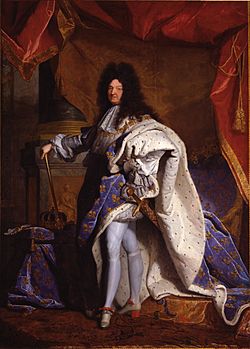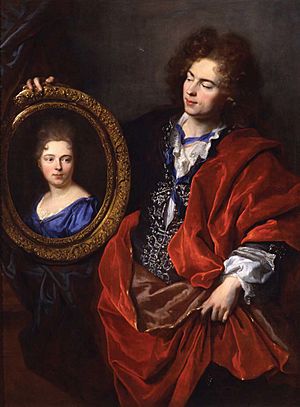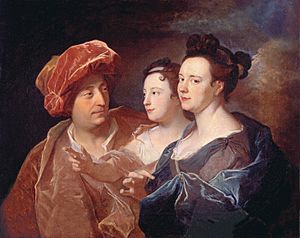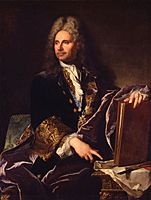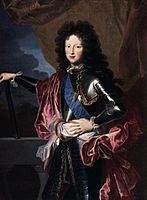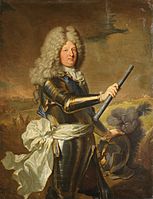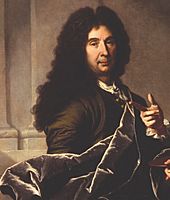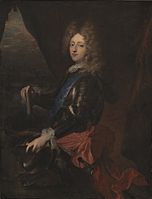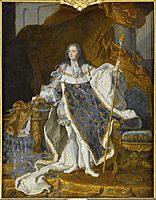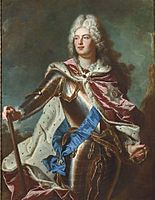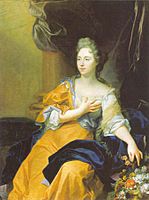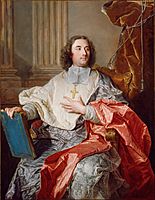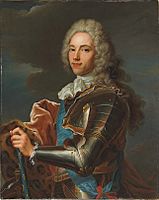Hyacinthe Rigaud facts for kids
Quick facts for kids
Hyacinthe Rigaud
|
|
|---|---|
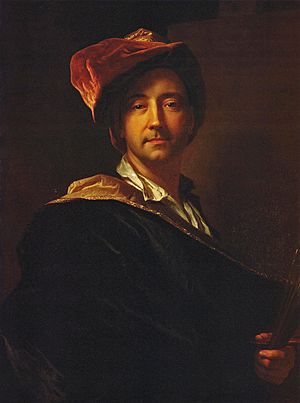
Self-portrait in a turban, 1698, Perpignan, Musée Hyacinthe Rigaud.
|
|
| Born |
Jacint Rigau-Ros i Serra
18 July 1659 |
| Died | 29 December 1743 (aged 84) Paris, France
|
| Nationality | French |
| Education | Charles Le Brun Paul Pezet (presumed) Antoine Ranc (presumed) |
| Known for | painting, portraiture |
|
Notable work
|
coronation portrait of Louis XIV; The Presentation in the temple; portrait of Bossuet in winter costume; portraits of Louis XIV |
| Movement | Baroque |
| Awards | Prix de Rome 1682 |
Hyacinthe Rigaud (born Jacint Rigau-Ros i Serra; July 18, 1659 – December 29, 1743) was a famous French painter. He was known for his amazing portraits, especially of King Louis XIV and other important people in France. He is considered one of the best French portrait artists from the classical period.
About Hyacinthe Rigaud
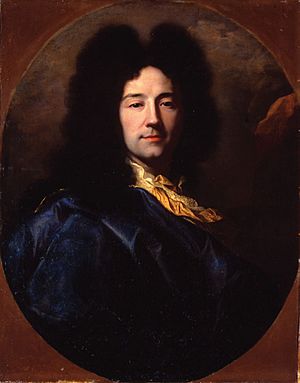
Rigaud was born in Perpignan in 1659. At that time, Perpignan was part of Spain. A few months after he was born, the city became part of France. His family, the Rigau, were from Catalonia. His father was a tailor and also a painter. Hyacinthe's family had a history of artists in the Perpignan area.
He was baptized with his Catalan name, Jacint Rigau i Ros. After his hometown became French, his family stayed there and became French citizens.
Hyacinthe first learned tailoring in his father's shop. But he really wanted to paint. He trained with Antoine Ranc in Montpellier starting in 1671. Four years later, he moved to Lyon. In these cities, he learned about different painting styles from artists like Rubens, Van Dyck, Rembrandt, and Titian. He even collected some of their works later on.
In 1681, Rigaud moved to Paris. The next year, he won a very important scholarship called the Prix de Rome. This award usually meant a trip to Rome to study art. However, a famous artist named Charles Le Brun advised him not to go. Instead, Rigaud focused on his painting in Paris.

Rigaud became a member of the Royal Academy of Painting and Sculpture in 1710. He rose to the top ranks of this art institution before he retired in 1735.
Rigaud's paintings were very detailed. He captured exact likenesses of people, their clothes, and the backgrounds. Because of this, his paintings are like precise records of what was fashionable at the time.
In 1695, Rigaud traveled to paint his mother's portrait. He painted her from many angles. He even had a marble statue of her made by a famous sculptor named Antoine Coysevox. This statue was very important to Rigaud for the rest of his life.
Rigaud also painted two versions of "Christ on the Cross" in 1695. These showed a strong influence from Flemish art. This was rare for him, as he usually painted portraits.
In 1709, his hometown of Perpignan made him a noble. In 1727, he was made a knight of the Order of Saint Michael. Hyacinthe Rigaud died in Paris in 1743 when he was 84 years old.
Important Clients
Hyacinthe Rigaud was one of the most important portrait painters during the time of King Louis XIV. He was very good at creating impressive poses and grand presentations. This style perfectly suited the kings, ambassadors, church leaders, and wealthy people who came to him for portraits.
Rigaud became famous because he had the support of four generations of the Bourbon royal family. He painted King Louis XIV, then his son, then his grandson, and finally his great-grandson, who became King Louis XV.
He also painted many other important people. His clients included rich families, bankers, nobles, business owners, and government ministers. He also painted many ambassadors and even some European kings. His work shows a complete picture of the most important people in France from 1680 to 1740. He also painted some people who were not famous, like his friends, other artists, or simple business people.
Rigaud's most famous painting is the 1701 portrait of Louis XIV in his coronation robes. This painting is now in the Louvre Museum in Paris. King Louis XIV also asked for a second copy, which is now at the Palace of Versailles.
His paintings are like "photographs" of faces. They are now in major museums around the world.
His Art Legacy
Rigaud's paintings are displayed in major museums worldwide. He kept a very detailed list of his works. Specialists believe he used over a thousand different models for his paintings. Many more paintings have been found since his records were published in 1919.
Rigaud painted many important figures from the art world. These included sculptors like Desjardins and Coysevox, and painters like Mignard. He also painted famous architects, poets like La Fontaine, and religious leaders like Bossuet. Many powerful archbishops and bishops paid a lot of money for their portraits.
In 1820, a museum in Perpignan, France, was named after him: the Musée des beaux-arts Hyacinthe Rigaud. It is still open today and shows some of his works.
Selected Works
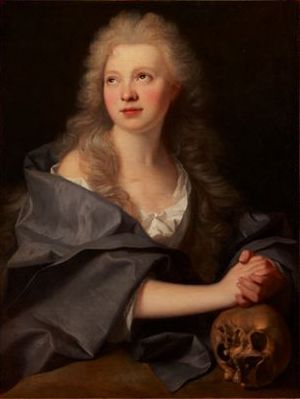
- Portrait of Graf Philipp Ludwig Wenzel von Sinzendorf, 1712, oil on canvas, 166 x 132 cm, Kunsthistorisches Museum, Vienna
- Portrait of Philippe de Courcillon, Marquis de Dangeau, 1702, oil on canvas, 162 x 150 cm, Musée national du château de Versailles et des Trianons, Versailles
- Portrait of Louis XIV, 1701, oil on canvas, 279 x 190 cm, Musée du Louvre, Paris
- Portrait of Louis XIV, c. 1700, oil on canvas, Centre Block, Parliament of Canada, Ottawa
- Portrait of the artist's mother, 1695, oil on canvas, 83 x 103 cm, Musée du Louvre, Paris
- Portrait of Everhard Jabach, 1688, oil on canvas, 58.5 x 47 cm, Wallraf-Richartz Museum, Cologne
- Portrait of Pierre Imbert Drevet, c. 1700, oil on canvas, 116 x 89 cm, Musée des beaux-arts de Lyon, France
- Portrait of Louis XV of France at the age 5, wearing the Coronation Robes, 1715, oil on canvas, Musée national du château de Versailles et des Trianons, Versailles
- Portrait of Elizabeth Charlotte of the Palatinate, c. 1719, oil on canvas, Musée national du château de Versailles et des Trianons, Versailles
- Portrait of Frederick IV of Denmark, Nationalhistoriske Museum, Frederiksborg Palace, Denmark
- Portrait of Augustus II the Strong, oil on canvas, 1715, Gemäldegalerie Alte Meister, Dresden
- Portrait of Cardinal Henri Oswald de La Tour d'Auvergne, 1732, oil on canvas, 142 x 113 cm, private collection.
Paintings
-
Portrait of Philippe d'Orléans, Duke of Chartres (1674–1723)
-
Frederick IV of Denmark as Crown Prince
-
Portrait of Louis XV, (1727–1729), Versailles
See also
 In Spanish: Hyacinthe Rigaud para niños
In Spanish: Hyacinthe Rigaud para niños


